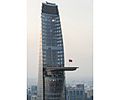Helipad facts for kids

A helicopter landing pad, often called a helipad, is a special area where helicopters can safely land and take off. Think of it like a runway for an airplane, but designed specifically for helicopters. Helipads are crucial for many reasons, from emergency medical transport to quick travel in busy cities.
Contents
What is a Helipad?
A helipad is a marked area, usually flat and strong, built for helicopters to land and take off. It's designed to be safe and clear of obstacles. Unlike an airplane, a helicopter can take off and land straight up and down. This means it doesn't need a long runway. Helipads make this possible in many different places.
Where are Helipads Found?
Helipads can be found in many locations around the world. Their placement depends on their purpose.
- Hospitals: Many hospitals have helipads, often on their roofs or nearby. These are vital for air ambulances to quickly bring injured or sick people for emergency care.
- Tall Buildings: In big cities, some tall buildings have helipads on their roofs. These are used for executive transport, allowing people to travel quickly above traffic.
- Ships: Large ships, especially military vessels, oil platforms, and cruise ships, often have helipads. These are called helidecks. They allow helicopters to transport supplies, personnel, or even perform rescue missions at sea.
- Remote Areas: Helipads are also built in hard-to-reach places like mountains, islands, or disaster zones. This allows helicopters to deliver aid or transport people where roads are not available.
- Private Properties: Some large private estates or resorts might have their own helipads for convenient travel.
Why are Helipads Important?
Helipads play a big role in modern transport and emergency services.
- Emergency Services: For emergency medical services (EMS), helipads are life-saving. They allow air ambulances to quickly reach accident scenes or transport patients to hospitals. This speed can make a huge difference in saving lives.
- Quick Transport: In busy cities, helicopters can avoid traffic jams. Helipads on buildings allow for fast travel for business people or important officials.
- Access to Remote Areas: Helicopters can reach places that are difficult or impossible for cars or boats. Helipads in these areas help with construction, exploration, or delivering supplies.
- Search and Rescue: During disasters or emergencies, helicopters use helipads as bases for search and rescue operations. They can bring in rescuers and take out people in need.
How are Helipads Designed?
Helipads are designed with safety in mind. They usually have specific markings and lighting.
- Markings: A common marking is a large "H" in the center, which stands for "Helicopter." There might also be a circle around the "H" and other lines to guide the pilot.
- Size and Strength: Helipads must be large enough for the helicopter to land safely. They also need to be strong enough to support the helicopter's weight.
- Lighting: For night landings, helipads have special lights. These lights outline the landing area and guide the pilot. There might also be a windsock nearby to show the wind direction.
- Safety Zones: Around the helipad, there's usually a clear area called a safety zone. This area must be free of obstacles like trees, buildings, or power lines.
Helipad vs. Heliport
You might hear the term "heliport" as well. While a helipad is just the landing area, a heliport is a larger facility. A heliport often includes:
- Multiple helipads.
- Fueling stations for helicopters.
- Maintenance facilities.
- Passenger terminals or waiting areas.
- Air traffic control services.
So, a helipad is like a single parking spot, while a heliport is like a small airport just for helicopters.
Images for kids
-
Helipad atop the SunAmerica Center in Century City, California, USA
-
Floating helipads of the American hospital ship USS Haven (AH-12) waiting for helicopters to bring in Korean War wounded.
-
Helipad atop the Eddystone Lighthouse offshore Rame Head
-
Yorkshire Air Ambulance helicopter landing on the roof of the Leeds General Infirmary
See also
 In Spanish: Helisuperficie para niños
In Spanish: Helisuperficie para niños











